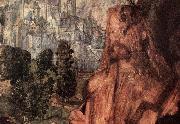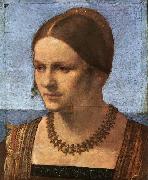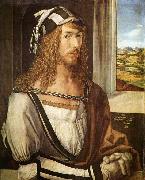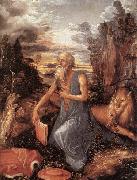All Albrecht Durer Oil Paintingsb.May 21, 1471, Imperial Free City of N??rnberg [Germany] d.April 6, 1528, N??rnberg |
|||
 |
|||
|
|
|
||||||||||
|
|
||||||||||
|
Feast of the Rose Garlands Gemälde IDENTIFIZIERUNG:: 63727 |
Feast of the Rose Garlands 1506 Oil on poplar panel National Gallery, Prague The detail shows the artist's self-portrait in front of ae typically German landscape.Artist:D?RER, Albrecht Title: Feast of the Rose Garlands (detail) Painted in 1501-1550 , German - - painting : religious 1506 Oil on poplar panel National Gallery, Prague The detail shows the artist's self-portrait in front of ae typically German landscape.Artist:D?RER, Albrecht Title: Feast of the Rose Garlands (detail) Painted in 1501-1550 , German - - painting : religious |
|||||||||
|
|
||||||||||
|
|
Portrait of a Venetian Woman Gemälde IDENTIFIZIERUNG:: 63729 |
Portrait of a Venetian Woman 1506-07 Oil on poplar panel, 28,5 x 21,5 cm Staatliche Museen, Berlin The painting is poorly conserved. Almost all the final layers of colour are missing. The eyes have been restored. Because of the absence of the topmost layer of colour, the painting has acquired a soft chromatic shading. Even if we know that D?rer executed it during his second sojourn in Italy, probably in the autumn of 1506 after the Feast of the Rose Garlands, workmanship seems particularly "Venetian." The refinement of the artist is clearly absent in the sketching of the hair. Some object is discernible in the curl hanging to the left. Only a few traces of the hairnet have been preserved, and the sky blue of the background, which is inexplicably divided into two sections, is probably no longer its original shade. In its original state, however, this half-bust must have been in the Venetian style, because of her full, soft shapes, delicately modeled with a measured use of light. We must count this painting among the most beautiful works D?rer produced during his second sojourn in Venice. The various attempts to identify the model - for example, as Agnes D?rer, because of the letters AD on the trimming of the clothes or the woman with her head turned in the middle right of the Feast of the Rose Garlands - have not held up to criticism. The letters are probably the initials of a motto.Artist:D?RER, Albrecht Title: Portrait of a Venetian Woman Painted in 1501-1550 , German - - painting : portrait 1506-07 Oil on poplar panel, 28,5 x 21,5 cm Staatliche Museen, Berlin The painting is poorly conserved. Almost all the final layers of colour are missing. The eyes have been restored. Because of the absence of the topmost layer of colour, the painting has acquired a soft chromatic shading. Even if we know that D?rer executed it during his second sojourn in Italy, probably in the autumn of 1506 after the Feast of the Rose Garlands, workmanship seems particularly "Venetian." The refinement of the artist is clearly absent in the sketching of the hair. Some object is discernible in the curl hanging to the left. Only a few traces of the hairnet have been preserved, and the sky blue of the background, which is inexplicably divided into two sections, is probably no longer its original shade. In its original state, however, this half-bust must have been in the Venetian style, because of her full, soft shapes, delicately modeled with a measured use of light. We must count this painting among the most beautiful works D?rer produced during his second sojourn in Venice. The various attempts to identify the model - for example, as Agnes D?rer, because of the letters AD on the trimming of the clothes or the woman with her head turned in the middle right of the Feast of the Rose Garlands - have not held up to criticism. The letters are probably the initials of a motto.Artist:D?RER, Albrecht Title: Portrait of a Venetian Woman Painted in 1501-1550 , German - - painting : portrait |
||||||||
|
|
||||||||||
|
|
Self-Portrait at 26 Gemälde IDENTIFIZIERUNG:: 63730 |
Self-Portrait at 26 1498 Oil on panel, 52 x 41 cm Museo del Prado, Madrid This self portrait is dated 1498 and inscribed: `I have thus painted myself. I was 26 years old. Albrecht D?rer.' Since the artist turned 27 on the 21 May, the picture must date from the beginning of the year. The artist's pose is self confident, showing him standing upright and turning slightly to lean his right arm on a ledge. D?rer's figure fills the picture, with his hat almost touching the top. His face and neck glow from the light streaming into the room and his long curly hair is painstakingly depicted. Unlike his earlier self portrait, he now has a proper beard, which was then unusual among young men. Nine years later D?rer wrote an ironic poem in which he described himself as `the painter with the hairy beard'. The artist's clothing is flamboyant. His elegant jacket is edged with black and beneath this he wears a white, pleated shirt, embroidered along the neckline. His jaunty hat is striped, to match the jacket. Over his left shoulder hangs a light-brown cloak, tied around his neck with a twisted cord. He wears fine kid gloves. Inside the room is a tall archway, partly framing D?rer's head, and to the right a window opens out onto an exquisite landscape. Green fields give way to a tree-ringed lake and beyond are snow-capped mountains, probably a reminder of D?rer's journey over the Alps three years earlier. Depicting a distant landscape, viewed through a window, was a device borrowed from Netherlandish portraiture. The Germans still tended to consider the artist as a craftsman, as had been the conventional view during the Middle Ages. This was bitterly unacceptable to D?rer, whose second Self-Portrait (out of three) shows him as slender and aristocratic, a haughty and foppish youth, ringletted and impassive. His stylish and expensive costume indicates, like the dramatic mountain view through the window (implying wider horizons), that he considers himself no mere limited provincial. What D?rer insists on above all else is his dignity, and this was a quality that he allowed to others too. This picture was acquired by Charles I of England and later bought by Philip IV of Spain.Artist:D?RER, Albrecht Title: Self-Portrait at 26 Painted in 1501-1550 , German - - painting : portrait 1498 Oil on panel, 52 x 41 cm Museo del Prado, Madrid This self portrait is dated 1498 and inscribed: `I have thus painted myself. I was 26 years old. Albrecht D?rer.' Since the artist turned 27 on the 21 May, the picture must date from the beginning of the year. The artist's pose is self confident, showing him standing upright and turning slightly to lean his right arm on a ledge. D?rer's figure fills the picture, with his hat almost touching the top. His face and neck glow from the light streaming into the room and his long curly hair is painstakingly depicted. Unlike his earlier self portrait, he now has a proper beard, which was then unusual among young men. Nine years later D?rer wrote an ironic poem in which he described himself as `the painter with the hairy beard'. The artist's clothing is flamboyant. His elegant jacket is edged with black and beneath this he wears a white, pleated shirt, embroidered along the neckline. His jaunty hat is striped, to match the jacket. Over his left shoulder hangs a light-brown cloak, tied around his neck with a twisted cord. He wears fine kid gloves. Inside the room is a tall archway, partly framing D?rer's head, and to the right a window opens out onto an exquisite landscape. Green fields give way to a tree-ringed lake and beyond are snow-capped mountains, probably a reminder of D?rer's journey over the Alps three years earlier. Depicting a distant landscape, viewed through a window, was a device borrowed from Netherlandish portraiture. The Germans still tended to consider the artist as a craftsman, as had been the conventional view during the Middle Ages. This was bitterly unacceptable to D?rer, whose second Self-Portrait (out of three) shows him as slender and aristocratic, a haughty and foppish youth, ringletted and impassive. His stylish and expensive costume indicates, like the dramatic mountain view through the window (implying wider horizons), that he considers himself no mere limited provincial. What D?rer insists on above all else is his dignity, and this was a quality that he allowed to others too. This picture was acquired by Charles I of England and later bought by Philip IV of Spain.Artist:D?RER, Albrecht Title: Self-Portrait at 26 Painted in 1501-1550 , German - - painting : portrait |
||||||||
|
|
||||||||||
|
|
St Jerome in the Wilderness Gemälde IDENTIFIZIERUNG:: 63731 |
St Jerome in the Wilderness 1495 Oil on panel, 23 x 17 cm National Gallery, London St Jerome kneels as a penitent. In his right hand he holds the Bible, which he translated into Latin, and in his left hand the stone which he is using to beat his breast. His eyes stare upwards, beyond the small crucifix stuck into the tree trunk. Wearing a blue gown, his red mantle and cardinal's hat lie beside him on the ground. Behind is his faithful lion, befriended after he had removed a thorn from its paw. In the background is a landscape with dramatic rock formations, probably based on sketches that D?rer had made of the quarries near Nuremberg. The scene is lit by a dramatic evening sky. The reverse of the panel depicts an apocalyptic celestial phenomenon, a red star-like light and a streaking golden disc. Although some scholars have considered it to be an eclipse or meteor, it is almost certainly a comet. D?rer's image is probably derived from woodcuts of comets published in the Nuremberg Chronicle of 1493. A similar object to the one painted by D?rer appears in the sky of his engraving of Melencolia I, made 20 years later. This small panel was only recognized as a D?rer in 1956. Art historian David Carritt realized that the lion is similar to that in a gouache which D?rer painted in Venice in 1494.Artist:D?RER, Albrecht Title: St Jerome in the Wilderness Painted in 1501-1550 , German - - painting : religious 1495 Oil on panel, 23 x 17 cm National Gallery, London St Jerome kneels as a penitent. In his right hand he holds the Bible, which he translated into Latin, and in his left hand the stone which he is using to beat his breast. His eyes stare upwards, beyond the small crucifix stuck into the tree trunk. Wearing a blue gown, his red mantle and cardinal's hat lie beside him on the ground. Behind is his faithful lion, befriended after he had removed a thorn from its paw. In the background is a landscape with dramatic rock formations, probably based on sketches that D?rer had made of the quarries near Nuremberg. The scene is lit by a dramatic evening sky. The reverse of the panel depicts an apocalyptic celestial phenomenon, a red star-like light and a streaking golden disc. Although some scholars have considered it to be an eclipse or meteor, it is almost certainly a comet. D?rer's image is probably derived from woodcuts of comets published in the Nuremberg Chronicle of 1493. A similar object to the one painted by D?rer appears in the sky of his engraving of Melencolia I, made 20 years later. This small panel was only recognized as a D?rer in 1956. Art historian David Carritt realized that the lion is similar to that in a gouache which D?rer painted in Venice in 1494.Artist:D?RER, Albrecht Title: St Jerome in the Wilderness Painted in 1501-1550 , German - - painting : religious |
||||||||
|
|
||||||||||
| VORHERIGER KÜNSTLER NÄCHSTER KÜNSTLER | ||||||||||
|
|
||||||||||
| Albrecht Durer | ||||||||||
| b.May 21, 1471, Imperial Free City of N??rnberg [Germany] d.April 6, 1528, N??rnberg | ||||||||||
|
|
||||||||||
|
KONTAKTIEREN Sie UNS |









